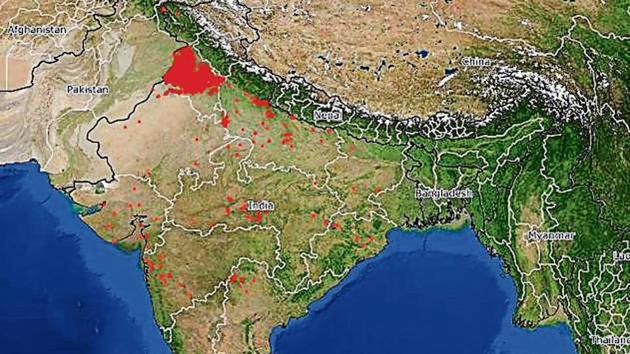Stubble burning emissions will double by 2050, if not controlled, says PGI study
The study ‘Emissions of air pollutants from primary crop residue burning in India and their mitigation strategies for cleaner emissions’ has been published in the Journal of Cleaner Production this month.
Satellite images for Saturday noon show Punjab covered with red spots, pointing to stubble burning at over 2,000 places. A study by the PGIMER shows that if timely measures are not taken to check stubble burning, a major contributor to air pollution, the emissions will almost double by 2050.

The image shared by Dr Ravindra Kahiwal, environmentalist from the Postgraduate Institute Of Medical Education and Research (PGIMER), shows 2,328 fire spots detected during the satellite overpass.
He has recently come up with a study, which talks about how crop residue burning emissions will increase by 45% in 2050, with 2017 as the base year.
The study ‘Emissions of air pollutants from primary crop residue burning in India and their mitigation strategies for cleaner emissions’ has been published in the Journal of Cleaner Production this month.
It shows that 488 million tonnes of total crop residue was generated in India during 2017, and about 24% of it was burnt in agricultural fields.
Can be put to good use
However, this crop residue could have also be used for energy production in biomass power plants and has the potential of 120 TWh (terawatt hours) of electricity generation. This accounts for 10% of the total energy production of India.
The rice straw burning in agricultural fields was considered 80% in Punjab, Haryana and Himachal Pradesh, 50% in Karnataka and 25% in other states.
Rice and wheat contribute significantly to a total emission of PM2.5 and PM10 emissions from crop residue burning. The rice residue contributes 51% of the total PM2.5 emissions followed by wheat residue, which contributes 32% of the total PM2.5 emissions from crop residue burning.
Generally, wheat straw is used as fodder for cattle, but farmers do not prefer to use rice straw for cattle feed because it contains high silica, has low digestibility and nutritive values and may affect the health of livestock.
Further, the thin sowing window between the harvesting of kharif crops and rabi crops leads to stubble burning in fields.



